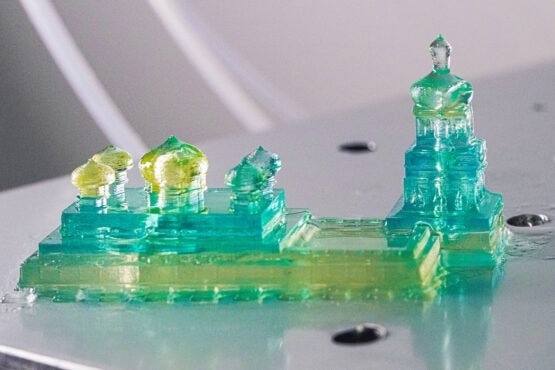3D printing breakthroughs have made it possible for engineers and designers to personalize projects, create physical prototypes at various scales, and build structures that were previously impossible to produce using more conventional manufacturing methods. However, the process is time-consuming and demands specific elements that must be used one at a time.

A model of Kyiv’s Saint Sophia Cathedral in the blue and yellow of the Ukrainian flag, made using the iCLIP method for 3D printing, which allows for the use of multiple types—or colors—of resin in a single object. Image Credit: William Pan.
Stanford scientists have created a 3D printing technology that aims to generate print instantly by combining different types of resin in a single element. Their design is 5 to 10 times quicker than the fastest high-resolution printing technology now available and may help researchers to utilize thicker resins with greater mechanical and electrical qualities.
The research was published in the journal Science Advances.
This new technology will help to fully realize the potential of 3D printing. It will allow us to print much faster, helping to usher in a new era of digital manufacturing, as well as to enable the fabrication of complex, multi-material objects in a single step.
Joseph DeSimone, Study Corresponding Author and Sanjiv Sam Gambhir Professor, Translational Medicine, Stanford University
Joseph DeSimone is also a Professor of Radiology and of Chemical Engineering at Stanford.
Controlling the Flow of Resin
The new design builds on a technique for 3D printing developed by DeSimone and his colleagues in 2015 known as continuous liquid interface production, or CLIP. CLIP printing appears to be something from a science fiction film, with a rising platform seamlessly pulling the object, apparently completely formed, from a thin puddle of resin.
A sequence of UV pictures transmitted across the pool hardens the resin at the surface into the desired form, while a layer of oxygen hinders curing at the pool's bottom and forms a “dead zone” where the resin remains liquid.
CLIP’s speed is determined by the dead zone. The liquid resin is expected to fill in behind the solid item as it rises, enabling smooth, uninterrupted printing. However, this may not always occur, specifically if the item rises too fast or the resin is too viscous. The scientists used this novel technology, termed injection CLIP, or iCLIP, to add more resin at key points by mounting syringe pumps on top of the growing platform.
The resin flow in CLIP is a very passive process—you’re just pulling the object up and hoping that suction can bring material to the area where it’s needed. With this new technology, we actively inject resin onto the areas of the printer where it’s needed.
Gabriel Lipkowitz, Study Lead Author and PhD Student, Mechanical Engineering, Stanford University
The resin is administered via conduits that are printed concurrently with the design. The conduits can be eliminated once the object is completed, or they can be included in the design in the same manner as veins and arteries are integrated into the human body.
Multi-Material Printing
By injecting extra resin separately, iCLIP prints with different kinds of resin simultaneously—each new resin merely requires its own syringe. The printer was evaluated with up to three separate syringes, each loaded with a different colored resin.
The investigators were successful in printing models of iconic buildings from other countries in the colors of their respective flags—Saint Sophia Cathedral in the blue and yellow of the Ukrainian flag and Independence Hall in American red, white, and blue.
The ability to make objects with variegated material or mechanical properties is a holy grail of 3D printing. The applications range from very efficient energy-absorbing structures to objects with different optical properties and advanced sensors.
Gabriel Lipkowitz, Study Lead Author and PhD Student, Mechanical Engineering, Stanford University
After demonstrating that iCLIP could print with multiple resins, DeSimone, Lipkowitz, and their co-workers set off to work on a software that optimizes the design of each printed piece’s fluid distribution network They anticipate providing designers precise control over the boundaries between resin types, which might speed up the printing process even more.
Lipkowitz concludes, “A designer shouldn’t have to understand fluid dynamics to print an object extremely quickly. We’re trying to create efficient software that can take a part that a designer wants to print and automatically generate not only the distribution network, but also determine the flow rates to administer different resins to achieve a multi-material goal.”
Journal Reference:
Lipkowitz, G., et al. (2022) Injection continuous liquid interface production of 3D objects. Science Advances. doi.org/10.1126/sciadv.abq3917.